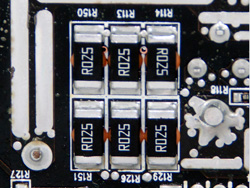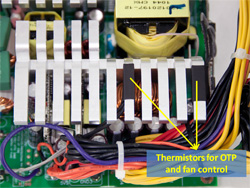A Detailed Look Into PSUs |
|
The Various Protections of a PSU
In this section we will make a reference to the various protections that a PSU has in order to avoid dramatic situations. Many budget PSUs have only the necessary protections that the ATX specification demands (OCP, SCP, OVP), but hi-end ones usually have much more.Power Good (PWR_OK)
As ATX specification states power good or PWR_OK signal is used by the PSU to indicate that the 5V, +3.3 V and +12V outputs are within the regulation thresholds of the power supply and that sufficient mains energy is stored by the converter to guarantee continuous power operation within specification for at least 16ms under full load. The PWR_OK according to ATX spec must be below 500 ms.
Over Current Protection (OCP)
An omni-present protection found in most PSUs. It kicks in when the current in the rails surpasses a limit. ATX 2.2 specification stated that if the load at each tested output rail reached or exceeded 240 VA then OCP should interfere (paragraph 3.4.4). However ATX 2.31 specification omitted the 240 VA limit. Many manufacturers, in order to bypass the 240 VA limit that the older ATX 2.2 specification had set, implemented many virtual +12V rails with each rail rated at 240 VA, however in most cases the OCP trigger point was set up much higher, in order to withstand peak currents.

To implement OCP in a PSU two things are necessary, a protections IC that supports OCP and shunt resistors. The latter are low resistance, high precision resistors used to measure the current at the outputs of a PSU, exploiting the voltage drops those currents create across them. By measuring the number of shunts in a PSU, in the area were +12V wires are soldered, we are able to find the real number of +12V virtual rails. In some cases, where the manufacturer built the PSU as multi +12V rail at first and then decided to convert it to single +12V rail, the shunt resistors are shorted together.
Over Voltage/Under Voltage Protection (OVP/UVP)
The ATX 2.31 specification states that the overvoltage protection sense circuitry and reference shall reside in packages that are separate and distinct from the regulator control circuitry and reference. So no single point fault shall be able to cause a sustained over voltage condition on any or all outputs. In other words all PSUs must have an independent protections circuit and not count solely on the PWM controller to monitor the output voltages. Here we must also add that UVP is optional since it's not mentioned in ATX specification!As you have already guessed OVP and UVP constantly check the voltages at each rail and kick in if these surpass a trigger point. The ATX 2.31 gives a table with the minimum, nominal and maximum values for the OVP trigger points. It includes the 5VSB rail although it states that OVP protection in this rail is recommended but not required! below you will find the relevant table.
| Output | Minimum (V) | Nominal (V) | Maximum (V) |
|---|---|---|---|
| +12 VDC (or 12V1DC & 12V2DC) | 13.40 V | 15.0 V | 15.6 V |
| +5 VDC | 5.74 V | 6.3 V | 7.0 V |
| +3.3 VDC | 3.76 V | 4.2 V | 4.3 V |
| 5VSB (optional) | 5.74 V | 6.3 V | 7.0 V |
Now as for the UVP trigger points, since they are not covered from the ATX specification each manufacturer of IC protection circuits is free to set his own.
Over Power Protection (OPP)
This protection kicks in when the power we pull from a PSU exceeds its maximum rated capacity. Usually the manufacturers give a little room for overpowering the PSU, so the OPP threshold is set 50-100 Watts (in some cases even more) above the maximum rated wattage of the PSU. In single +12V rail PSUs, where OCP practically is meaningless, OPP saves the day if something goes wrong.Over Temperature Protection (OTP)


When this protection is present we usually find a thermistor in the secondary heatsink (attention, the fan control unit very often uses a thermistor in the same heatsink). The thermistor informs the protections circuit about the temperature of the heatsink. If temperature exceeds a preset temperature point then the PSU is shut down. An excessive temperature maybe a result of overloading or cooling fan's failure so OTP prevents (further) damage to the PSU.
Short Circuit Protection (SCP)
This protection constantly monitors the output rails and if it finds an impedance of less than 0.1O then it immediately shuts down the power supply. In other words if somehow the output rails are short-circuited then this protection kicks in and shuts down the PSU, to prevent damage/fire. ATX 2.31 spec states that the two +12V rails should have separate short circuit.
May 2nd, 2024 11:00 EDT
change timezone
Latest GPU Drivers
New Forum Posts
- 7800x3d $216 in bundle at Microcenter (2)
- Current Sales, Bundles, Giveaways (10225)
- What's an inexpensive AIO product line with a strong pump and low price? (97)
- Aviation fuel, no co2 (9)
- Old high quality PSU, or semi-old mid-quality PSU? (43)
- TPU's Nostalgic Hardware Club (18492)
- Ryzen Owners Zen Garden (7281)
- 7900 XTX Seriously lacking (104)
- need help with power limiting my i7-8750h (7)
- Share your AIDA 64 cache and memory benchmark here (2926)
Popular Reviews
- Ugreen NASync DXP4800 Plus Review
- ASRock NUC BOX-155H (Intel Core Ultra 7 155H) Review
- Montech Sky Two GX Review
- HYTE THICC Q60 240 mm AIO Review
- Upcoming Hardware Launches 2023 (Updated Feb 2024)
- MOONDROP x Crinacle DUSK In-Ear Monitors Review - The Last 5%
- Team Group T-Force Vulcan ECO DDR5-6000 32 GB CL38 Review
- AMD Ryzen 7 7800X3D Review - The Best Gaming CPU
- Thermalright Phantom Spirit 120 EVO Review
- ASUS Radeon RX 7900 GRE TUF OC Review
Controversial News Posts
- Intel Statement on Stability Issues: "Motherboard Makers to Blame" (225)
- Windows 11 Now Officially Adware as Microsoft Embeds Ads in the Start Menu (159)
- Sony PlayStation 5 Pro Specifications Confirmed, Console Arrives Before Holidays (117)
- AMD's RDNA 4 GPUs Could Stick with 18 Gbps GDDR6 Memory (109)
- NVIDIA Points Intel Raptor Lake CPU Users to Get Help from Intel Amid System Instability Issues (106)
- AMD "Strix Halo" Zen 5 Mobile Processor Pictured: Chiplet-based, Uses 256-bit LPDDR5X (103)
- AMD Ryzen 9 7900X3D Now at a Mouth-watering $329 (98)
- TechPowerUp Hiring: Reviewers Wanted for Motherboards, Laptops, Gaming Handhelds and Prebuilt Desktops (93)